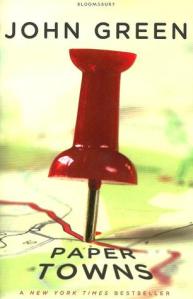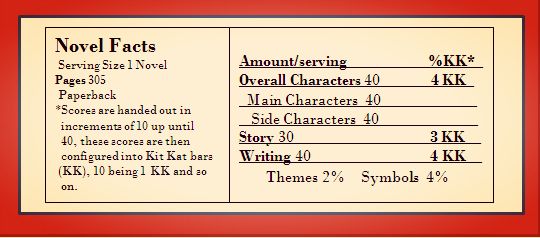- Published: October 16th, 2008
- Publisher: Dutton Books
- Genre: Young Adult Mystery
- Pages in Paperback: 305
- Quote: “What a treacherous thing it is to believe that a person is more than a person.” Pg. 282
- Goodreads
- Amazon
/Barnes and Noble/Book Depository

Plot:
Quentin Jacobsen has spent a lifetime loving the magnificently adventurous Margo Roth Spiegelman from afar. So when she cracks open a window and climbs back into his life – dressed like a ninja and summoning him for an ingenious campaign of revenge – he follows.
After their all-nighter ends and a new day breaks, Q arrives at school to discover that Margo, always an enigma, has now become a mystery. But Q soon learns that there are clues – and they’re for him. Urged down a disconnected path, the closer Q gets, the less Q sees the girl he thought he knew.
Review of the Characters:
Quentin– He was such a refreshing protagonist. It’s not often that I read a character I can relate too but Green has done it with Quentin. My number one complaint with young adult fiction is the need to write about ‘special’ characters. characters that for some reason or other are the best at a certain important trait. No one ever writes about the middle of the pack guy– not necessarily the smartest or most talented, just an average, everyday person. Quentin embodies this and not only that, but promotes the idea that being an everyday person can be rewarding as long as you surround yourself by people who matter. Cheesy, I know, but nice.
Margo– While Quentin was the character I identified with Margo was the character I aspired to be. I loved how gutsy she was, I loved that she lived in the present, something I definitely struggle with. Green defines Margo perfectly in the beginning of the novel. It’s in the prelude and the reader is seeing Margo and Quentin when they were small children, they go to the park only to make a horrific discovery. And while Quentin takes two steps back, Margo takes two steps forward. It’s a small detail but a defining one. She lives her life wide. And while many people had a problem with her believability I did not and here is the reason why, “And all at once I knew how Margo Roth Spiegelman felt when she wasn’t being Margo Roth Spiegelman: she felt empty. She felt the unscaleable wall surrounding her. I thought of her asleep on the carpet with only that jagged sliver of sky above her. Maybe Margo felt comfortable there because Margo the person lived like that all the time: in an abandoned room with blocked-out windows, the only light pouring in through holes in the roof. Yes. The fundamental mistake I had always made—and that she had, in fairness, always led me to make—was this: Margo was not a miracle. She was not an adventure. She was not a fine and precious thing. She was a girl.” Margo had embodied this persona, but it didn’t encompass her, it was just what everyone else saw, what Quentin (our eyes) saw. Quentin fell in love with the idea of Margo Roth Spiegelman, when in fact, she was just Margo and THAT is why she is believable.
Review of the Story:
The story is the only place that loses points for me. While the beginning and ending were entertaining and thought provoking, the middle was extremely slow. The thing that saves it is Green’s witty dialogue, but there a comes point when the trail of the mystery is cold and we are left with Quentin and his thoughts for a bit too long.
With that said though the plot of Paper Towns is a resonating one. I loved how Quentin’s friends immediately supported the idea of solving Margo’s mystery, no questions asked. In fact, I’m certain that the relationship between Quentin and his friends is just as important to consider as the relationship between Quentin and Margo, if not more so. Margo’s mystery causes Quentin to put himself in her shoes, trying to know her better but what happens is he learns a few life truths about himself too and that’s where his friends come in, to support him.
The road trip has to be the best scene ever. I especially love the way Green describes it as they are all running back to the car, “Radar revs the engine as if to say hustle, and we are running through the parking lot. Ben’s robe flowing in the wind so that he looks vaguely like a dark wizard, except that his pale skinny legs are visible, and his arms hug plastic bags. I can see the back of Lacey’s legs beneath her dress, her calves tight in midstride. I don’t know how I look, but I know how I feel: Young. Goofy. Infinite.” This is one sign of many that Quentin has started to grow from Margo’s mystery. (P.S.– Metaphysical I-Spy is now the only way I’ll play the game).
Review of the Writing:
This is where the book shines, for it is Green’s writing that pushes the bar from young adult to literature. Throughout the whole novel we are presented with three different metaphors that are supposed to represent the idea of humans.“We don’t suffer from a shortage of metaphors, is what I mean. But you have to be careful which metaphor you choose, because it matters. If you choose the strings, then you’re imagining a world in which you can become irreparably broken. If you choose the grass, you’re saying that we are all infinitely interconnected, that we can use these root systems not only to understand one another but to become one another. The metaphors have implications. Do you know what I mean?” Margo lived her life by the strings. The strings represented her old life; her friends, boyfriend and family and once she felt that those strings were broken, she in turn felt broken. While the grass was a metaphor Quentin used to try to understand Margo better, know her when she was alone and wasn’t being Margo Roth Spiegelman.
The metaphor that rings true with me is the cracks in us. “Maybe its like you said before, all of us being cracked open. Like each of us starts out as a watertight vessel. And then things happen – these people leave us, or don’t love us, or don’t get us, or we don’t get them, and we lose and fail and hurt one another. And the vessel starts to crack in places. And I mean, yeah once the vessel cracks open, the end becomes inevitable. Once it starts to rain inside the Osprey, it will never be remodeled. But there is all this time between when the cracks start to open up and when we finally fall apart. And its only that time that we see one another, because we see out of ourselves through our cracks and into others through theirs. When did we see each other face to face? Not until you saw into my cracks and I saw into yours. Before that we were just looking at ideas of each other, like looking at your window shade, but never seeing inside. But once the vessel cracks, the light can get in. The light can get out.” It is our faults that make us human, and in turn connect us. Green has described it beautifully here.
Rating:
Paper Towns was a book that caught me by surprise, I wasn’t expecting a provoking tale such as Quentin and Margo’s but it is a tale I will not forget. It’s a book that you will never tire of rereading because with Green’s writing you always learn something new. I recommend this book to all bookworms, read it if you haven’t all ready. You’ll learn a little something about yourself in the process.
Overall Rating:
P.S.– My next read is Daughter of the Winds by Jo Bunt




Pingback: Siege and Storm by Leigh Bardugo |
OH MY GOD, THE KITKAT. 😀 Awesome review of one of my all-time favorite books! I definitely agree that John Green’s writing saves the middle parts. If he wasn’t such an amazing writer, it probably wouldn’t have worked.
Haha, I know I get chocolate cravings all the time! Yeah, his writing is amazing, especially in this novel. Thanks for reading! 🙂
I’m starting to develop a love-hate relationship with your blog thanks to that gigantic Kit-Kat which is killing me! *drools* 😛
Why I love the Paper Towns:
#1 – Paper Towns is my second favorite John Green book(TFiOs is obviously the uncontested winner) especially because it was the first book by Green that I’ve read and forever thankful to this book for helping me discover one of my fave authors.
#2 – “…promotes the idea that being an everyday person can be rewarding as long as you surround yourself by people who matter. ” THIS. YA books sometimes focus too often on “extraordinary” characters and although isn’t a bad thing it’s nice to see an completely ordinary person every once in a while.
#3. Because John Green’s writing is the kind that pulls you in and holds you captive till the last line.
Brilliantly reviewed, Lindsey! Now I’m itching to re-read this one! 🙂
Haha, it can definitely give you the cravings!
Yeah, this was the second book by John Green that I read (the first was TFiOS) and I was so pleased to know that he wasn’t a one hit wonder, but a brilliant author.
Thank you! While one book as a whole about ‘extraordinary’ characters isn’t necessarily bad as a whole it could have a negative effect on youth. So its refreshing to see John Green highlight the perks of being an average joe.
His writing is AMAZING and what truly makes this story what it is, brilliant!
Thank you so much for reading and your comment, I really appreciate it! 🙂
I love the quote at the top.
Me too, it says so much! Thanks for reading! 🙂
Pingback: Bloggin’ Recap: February 9th-15th |